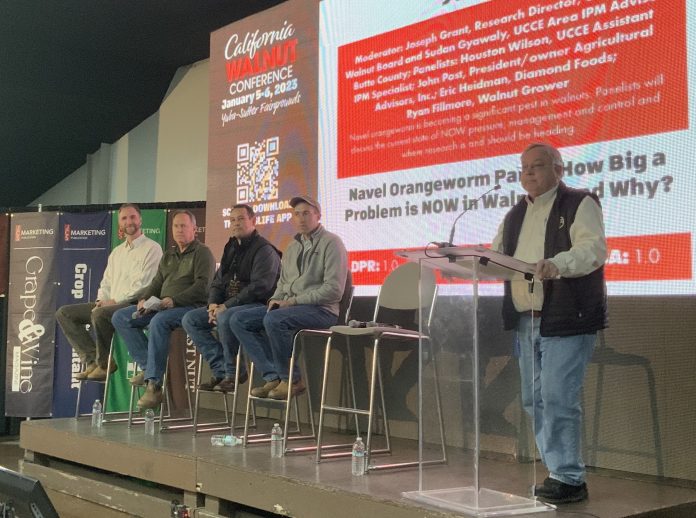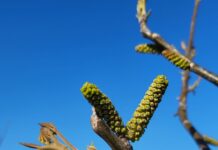
Across the board, a PCA, grower and processor agreed that navel orangeworm (NOW) infestations in walnut orchards were a growing concern. A robust discussion on management of this pest during the California Walnut Conference included diverse opinions and possible solutions to the NOW challenge.
Navel orangeworm, Amyelois transitella, damages walnuts once the husks split. Blighted or sunburned nuts also offer entry for egg laying. Larvae feed on the kernel and produce frass and webbing, making the nut unmarketable. Unlike codling moth, more than one NOW can infest each nut. Infested walnut crops take longer to process, increasing costs.
Navel orangeworm overwinters as larvae inside mummy nuts on the tree and in trash nuts left on the ground. Depending on winter and spring temperatures, pupation begins in March. Moths of the overwintered NOW brood begin emerging in April, and peak emergence usually occurs from late April to mid-May, depending on season and growing region. Female NOW of the overwintered generation lay their eggs singly on mummy nuts, codling moth-infested nuts or blighted nuts. The first generation, and most of the second, is completed in these nuts. As the growing season progresses, some of the second-generation larvae infest the nuts as the husks begin to split. Females emerging at this time prefer to lay eggs on the opened husk or on the exposed nutshell. The UC IPM guidelines note that in later-harvested varieties, nuts may also be exposed to infestation by third-generation larvae.
What had been a mostly successful NOW suppression program for organic walnut grower Ryan Fillmore has changed in recent years. Fillmore, who farms walnuts in Butte County, said orchard sanitation and mass trapping had worked for him, keeping NOW pressure on the low end in his Chandler blocks up to 2021. Very specific flights and consistent numbers in trapping changed after 2021, he said. Navel orangeworm damage in 2022 had significant impact on his walnut crop, increasing processing costs.
“The population may not be increasing, but there is a year-to-year variation in flights and hull split,” Fillmore said.
John Post, PCA and president and owner of Agricultural Advisors Inc., said he first saw NOW damage in walnuts in the Durham area of Butte County in the 1970s. He said they figured out the flight cycle, and NOW damage at that time was never worse than codling moth damage. Control for that pest was keeping NOW in check, he said, but the insect kept adapting and pupating earlier, and more generations were produced.
There are regional differences, Post said, but in his experience, traps are constantly catching NOW, and due to poor sanitation practices, Post said he believes NOW is becoming problematic in walnuts.
There has been a gradual uptick in NOW damage in walnuts, Eric Heidman of Diamond Foods Inc. noted. More NOW damage in a grower’s walnut harvest will mean increased processing costs. Earlier varieties on southern growing regions are being most affected. At second shake, he said blocks of Tulare were approaching 5% NOW damage. 20% damage with late harvest was not uncommon.
“Testing, re-sort, re-pack, those costs kill returns,” Heidman said. The NOW damage is secondary to mold and aflatoxin development in walnuts. Customers are requesting lower levels, and the tolerance for aflatoxin in EU imports is low.
“Prevention at the field level is best,” Heidman said.
He also put NOW in perspective across the walnut industry. Over the entire crop, NOW damage is less than 1%.
NOW Defies Complete Control
Houston Wilson, UCCE IPM specialist, who has been studying NOW in the Central Valley for the past six years, noted the pest’s strength and challenge for control in the wide range of host plants. Growth of tree nut crops as a food supply and NOW’s flying ability defy complete control.
He stressed that orchard sanitation practices and destroying mummy nuts removes overwintering sites and potentially lowers numbers for the first flight. Wilson recognized that orchard access for sanitation may be limited during wet weather, and research efforts are being directed in that area.
What is needed is a better way to approach areawide control efforts, Wilson said. Sanitation by individual growers is compromised when neighbors fail to shake and destroy mummy nuts. Better orchard sanitation and timing of spray applications is important for the future, Wilson said, but development of tools and study of NOW movement including timing of influx into walnuts along with economic considerations will be needed by growers.
“Those are our highest concerns, but it is difficult for growers when prices are low. We have to figure out areawide management of this pest,” Wilson added.
There are not enough tools available for NOW control, Post noted. Pyrethroids have been a good fit, but he questioned how much longer growers would be able to use those products. More point sources are needed for pheromone use in mating disruption, Post said, and it can be less effective due to the large size of mature trees.
No one has come up with a complete solution to NOW control at any price, Fillmore said. He said there have been dramatic differences in population levels from year to year. Traps give some idea of population levels. It is critical, he added to know appropriate spray timing. Growers can’t cut out control options as there is too much of an economic impact from NOW.
“Where can you cut?” Post asked. Blight spray? Blight invites more NOW damage. NOW lay eggs on infected nuts, he said.
Post said he recommends putting the sterilant application on with the contact burn strip spray down the berm prior to harvest.
“You don’t have to blow and mow after the harvest to put your strip spray on, and you can time the blowing and mowing more for NOW timing when more mummies are on the ground for control in late January or early February.”
Fillmore pointed out that mummy nuts are hanging on the trees longer, prompting changes in cover cropping and mowing.
“When is it critical to have mummies gone? What is the best timing?” he asked.
Post noted that with cover crops, waiting until March to mow will not work. Those should be gone by Feb. 15, he said.
Mating disruption, panelists agreed, is another tool for NOW control, but in walnuts, the cost of dispensers and the ability of mated NOW females to fly in from adjacent orchards was cited.
Staggered phenology and travel into orchards pose challenges, Wilson said. What is needed is a mapping tool to predict incoming NOW and when mating disruption would be most effective.
“This is why no single thing works,” Fillmore said. “They always have habitat and can fly.”










